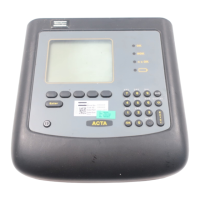ACTA 4000 User Guide Programming ACTA
9836 4171 01 2008-12 37 (136)
Window Menu item Description
Subgroup statistics
torque/angle/pulses
X-bar min.
Minimum mean torque for subgroups.
X-bar max.
Maximum torque/angle/no of pulses for subgroups.
R min.
Minimum torque/angle/no of pulses R (range) for subgroups.
R max.
Maximum torque/angle/no of pulses R (range) for subgroups.
X-bar last
Mean torque/angle/no of pulses for the last subgroup.
R last
Torque/angle/no of pulses R (range) for the last subgroup.
CAM
CAM value for Torque/angle/no of pulses.
At least six (6) subgroups must be in
existence for the CAM value.
ACTA supports testing motor driven tools according to the ISO 5393 standard. This information window
is only accessible when the selected tool is created from an ISO 5393 calibration. It contains:
Window Menu item Description
ISO 5393 statistics
torque/angle
Comb mean
torque
Combined mean torque
Mean shift
Mean shift
Comb torque
scatter
Combined torque scatter
Comb angle
scatter
Combined angle scatter
See section ISO 5393 calculations for more information.
The parameters presented in this window are based on the active tool and the
corresponding hard/soft joint tool. That is, if the selected tool is the Low Torque,
Hard Joint tool. The tools making up the statistics here are the two Low Torque tools
(Hard joint and Soft Joint). In the same way The Hard/Soft joint tools with High
Torque make up their ISO 5393 statistics window.
4.4.3 History
Together with the programming parameters and tightening operations, history parameters are also
included in the statistics database.
Each time all tightening operations are removed from a tool by means of
shift, Cl or Database>Clear all
measurements,
ACTA calculates new X (mean), R (range) and σ (standard deviation) values and saves
them in the history memory.

